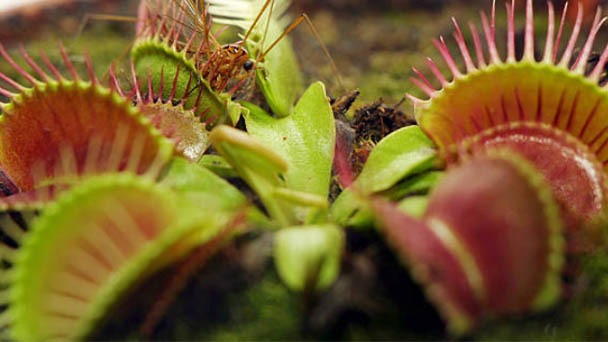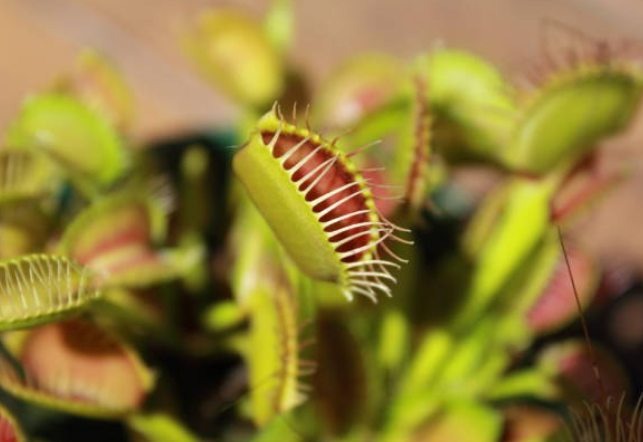How Does the Venus Flytrap Work?
Written by Ivy
Jan 03 2023

The Venus flytrap is a species of carnivorous plant that can do exactly what its name implies: capture and absorb flies. How does the venus flytrap work? Where do venus flytraps thrive the most, how do these almost mythical plants function, and how can we grow and take care of them? We go over all the essential information about venus flytraps and other carnivorous plants in this article.
What is a Venus Flytrap?
The most well-known carnivorous plants are venus flytraps, which can capture insects and flies before consuming them. These fascinating, evergreen plants use sweet nectar to draw flies into their jaw-like leaves.
An electric charge is sent through the plant signaling that prey is present when something touches the inside hairs of their "trap," and the trap snaps shut, enclosing the insect. The trap closes more tightly the more the prey moves, making it difficult for the captured fly to escape. The edge of the trap is lined with interlocking teeth.
It appears that venus flytraps have good short-term memory because the trigger hairs need to be stimulated twice within 20 seconds for the trap to close. (Read More: Venus Fly Trap Light Requirements - Does It Need Direct Sunlight?)
How Does a Venus Flytrap Close Up?
The stalk of a Venus flytrap leaf has two lobes that are joined at a hinge. To entice insects, every lobe secretes nectar. Furthermore, cilia hairs that will later appear to some unfortunate prey as prison bars line each lobe of the body.
The lobes themselves are curved out and stretched open like a clam. Three sensory hairs are found in each inner lobe. The cells at the base of the hair respond to mechanical stimuli by producing electrical signals, whether it be a raindrop, wind-blown debris, or an intruding insect. The electrical signals then spread throughout the leaf.
Most likely, the sensory hairs will be repeatedly bumped by an insect crawling on a lobe. However, the lobes can clamp shut, imprisoning the prey, with just two bumps within 30 seconds of one another.
How does the Venus flytrap measure the space between these bumps, then? The involvement of calcium ions in some way has long been a matter of scientific speculation.
This was definitively confirmed in October 2020, when researchers at the National Institute of Basic Biology in Okazaki, Japan, published a study in the peer-reviewed journal Nature Plants showing that changes in calcium concentrations inside leaf cells helped the plant keep time.
By genetically modifying Venus flytraps to produce green fluorescence when calcium ions were present in the leaf cells, the researchers were able to achieve their goal. The scientists could immediately see the elevated calcium ion concentration as a green glow after stimulating the sensory hairs. There would be a gradual loss of concentration. The calcium concentration was then again increased by a subsequent stimulus. The trap closed when the calcium concentration fell below a predetermined level. However, this threshold could only be crossed if the two stimuli happened to occur 30 seconds apart.
However, the 30-second rule of two bumps doesn't always hold true. It has been demonstrated by researchers at the University of Zurich in Switzerland that even sluggish creatures can become entangled in the Venus flytrap's net.
They investigated how much and how long of a force on sensory hairs was required to cause a trap to close using precise microrobots and highly sensitive sensors. Using this information, a mathematical model was developed to predict how the plant would respond to stimuli from prey of various sizes. One slow touch could generate the two electrical signals required to close the trap, according to their model, which they were later able to experimentally confirm. Thus, slower-moving ants and flies as well as snails and caterpillars are equally likely to become a meal.
What Happens When An Insect is Captured?
The trap partially closes after an insect is caught. The bug can still crawl out if it is small enough. The plant does this to make sure that the prey is large enough to warrant the effort required for digestion, which is the next stage. As a result, if the frightened bug is large enough, the leaf will close even tighter around it and begin to release digestive fluids to disintegrate the prey for absorption. If you'd like to learn more about it, check out this wonderful article by science writer Ed Yong in The Atlantic. The Botanical Society of America website also provides a useful overview of Venus flytraps and how to grow them.
Only the coastal bogs of North Carolina and South Carolina are home to the endangered Dionaea muscipula, also known as the Venus flytrap. It has been suggested to list them as endangered species because they are getting harder to find. Their main issue is habitat loss, which is a result of both development and the absence of forest fires that would otherwise clear out invasive plants. Their decline in the wild is largely due to plant poaching as well. Venus flytraps are readily available at reputable nurseries if you want to grow one.

Do Venus Flytraps Actually Eat Flies?
Using digestive enzymes, the venus flytrap dissects the fly's soft tissue after it has been caught and then consumes it as a wholesome meal. After a week has passed since the previous catch, the trap reopens and is ready for another, using what is left of the fly to draw in new prey.
Venus flytraps are powerful plants, but they aren't always successful. When larger insects get caught, like spiders, they can easily chew through the plant to get away, and if the plant absorbs the wrong insects, it could suffer damage.
Additionally, this clarifies the frequently asked question of whether venus flytraps poop. Due to their lack of a digestive system, flies are absorbed by the plant's enzymes.
Why Do Venus Flytraps Go After Small Insects and Spiders?
Similar to other carnivorous plants, Venus flytraps evolved in nutrient-poor environments, which led to a special adaptation: capturing live animals for extra food. Other carnivorous plants, like the waterwheel, have evolved movements to capture live prey. But none of them have the dramatic trapping effect of the Venus flytrap, which inspired Audrey II, the star of "'Little Shop of Horrors'"
Do Venus Flytraps Have Brains?
The nervous system and brain are absent from venus flytraps.
Zmescience.com state that their "remarkable ability is owed to the plant's short-term memory. Venus flytraps can actually "count" to five, according to earlier studies. The trap closes after two touches within a 20-second window, whereas five touches increase the production of digestive enzymes."
Research documented in the Nature Plants journal in 2020 suggests that The short-term memory of Venus flytraps is a result of sophisticated calcium signaling. The leaves close when enough calcium is found in them.
Can a Venus Flytrap Hurt a Person?
A venus flytrap is incapable of harming a person. Because it causes the venus flytrap to use energy unnecessarily, what will happen if you stick your finger in one is actually more harmful to the plant than it is to you.
The truth is that humans threaten venus flytraps much more than the other way around. If not properly maintained, these carnivorous plants can be easily killed. They require specific compost and cannot be fed tap water, for instance.
Bottom Line
Small sensory hairs in the leaf lobes of venus flytraps alert them to potential prey, causing the snap-trap lobes to violently clamp down on small insects and spiders.
FAQs
Do Venus Fly Traps Actually Eat Flies?
Do venus flytraps actually consume flies? Once trapped, the venus flytrap uses digestive enzymes to break down the soft tissue of the fly before absorbing it as a nutritious meal. A week after a catch, the trap reopens and is ready for another, luring new prey with what's left of the fly.Is It OK to Touch a Venus Flytrap?
And it turns out that if you stick your finger into a trap, nothing's really going to happen. The trap will begin to close if you move your finger slightly in order to activate those trigger hairs.How Long Do Venus Fly Traps Stay Alive?
Venus flytraps are perennial, carnivorous plants that can live up to 20 years in the wild. Insects provide nutrients that aren't easily accessible in the soil, even though they get the majority of their energy from photosynthesis.
Read More About Venus Flytraps
- Will Venus Fly Trap Bloom Flowers - Is It a Perennial Plant
- Are Venus Fly Traps Animals or Plants - Are They Illegal?
- How Long Can Venus Flytraps Live - Venus Flytrap Life Cycle
- How to Repot a Venus Flytrap
- How Much Does Venus Flytrap Cost
- How Does A Venus Flytrap Kills & Eat Insect - RayaGarden
- How Big Do Venus Flytrap Get - Growth Rate & Speed
Latest Updated
- Benefits of Bugleweed - 7 Science-backed Health Benefits
- Bugleweed Dangers & Side Effects - Is It Poisonous?
- How to Plant Evergreen Trees - What You Should Know
- When to Plant Evergreens - Grow Guide for Evergreen Trees
- 12 Wonderful Evergreen Shrubs for Your Garden
- 12 Popular Evergreen Plants with Pictures for Beginners
- When And How To Prune A Lilac Bush Like a Pro
- How to Grow & Care for Lilac Vine (Hardenbergia Violacea)
- Japanese Lilac Tree (Syringa Reticulata) Care & Propagation Guide
- Shumard Oak Pros and Cons - What to Know
Popular Articles
- Winter maintenance of Antirrhinum Majus
- How to Grow Terminalia Mantaly Tree
- How to Grow and Care for Crossostephium Chinense
- How to grow Antirrhinum Majus in spring
- Peristeria Elata (Dove Orchid) Profile: Info & Care Guide
- Underwatered Snake Plant (Sansevieria Trifasciata) - Signs And How To Fix
- How to Care for Brazilian Jasmine Plant (Mandevilla Sanderi)
- How to Grow & Care for Graptopetalum Purple Delight in Summer
- Rosa Chinensis (China Rose): Plant Growing & Care Tips
- How to Care for Baby Sun Rose (Aptenia Cordifolia)